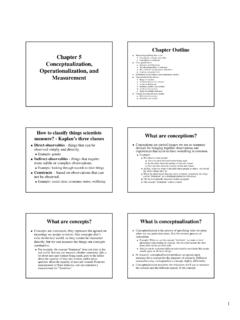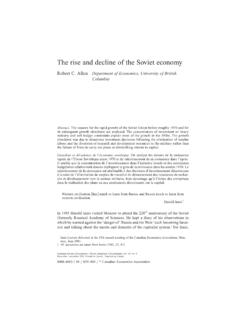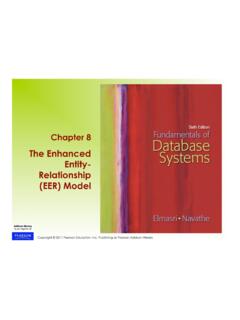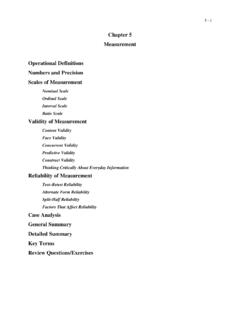Transcription of Chapter Outline Chapter 5 Conceptualization ...
1 1 Chapter 5 Chapter 5 Conceptualization , Conceptualization , Operationalization, and Operationalization, and MeasurementMeasurementChapter OutlineChapter Outline Measuring anything that existsMeasuring anything that exists Conceptions, concepts, and realityConceptions, concepts, and reality Conceptions as constructsConceptions as constructs ConceptualizationConceptualization Indicators and dimensionsIndicators and dimensions The interchangeability of indicatorsThe interchangeability of indicators Real, nominal, and operational definitionsReal, nominal, and operational definitions Creating conceptual orderCreating conceptual order Definitions in descriptive and explanatory studiesDefinitions in descriptive and explanatory studies Operationalization choicesOperationalization choices Range of variationRange of variation Variation between the extremesVariation between the extremes A note on dimensionsA note on dimensions Defining variables and attributesDefining variables and attributes Levels of measurementLevels of measurement Single for multiple indicatorsSingle for multiple indicators Criteria for measurement qualityCriteria for measurement quality Precision and accuracyPrecision and accuracy Reliability and validityReliability and validityHow
2 To classify things scientists How to classify things scientists measure? measure? --Kaplan s three classesKaplan s three classes Direct observablesDirect observables--things that can be things that can be observed simply and simply and directly. Example: gender Example: gender Indirect observablesIndirect observables--things that require things that require more subtle or complex subtle or complex observations. Example: looking through records to infer thingsExample: looking through records to infer things ConstructsConstructs--based on observations that can based on observations that can not be be observed. Example: social class, economic status, wellbeingExample: social class, economic status, wellbeingWhat are conceptions?
3 What are conceptions? Conceptions are mental images we use as summary Conceptions are mental images we use as summary devices for bringing together observations and devices for bringing together observations and experiences that seem to have something in common. experiences that seem to have something in common. Example: Example: We observe some peopleWe observe some people Talk a lot about men and women being equalTalk a lot about men and women being equal Go the rallies about the equality of men and womenGo the rallies about the equality of men and women Give speeches about the equality of men and womenGive speeches about the equality of men and women At first, when we want to describe these people to others, we liAt first, when we want to describe these people to others, we list all st all the above things they dothe above things they do When the phenomena become more common, somebody develops When the phenomena become more common.
4 Somebody develops a term feminism as a shorthand notion for efficiencya term feminism as a shorthand notion for efficiency This term eventually becomes widely accepted. This term eventually becomes widely accepted. The concept feminism is thus created. The concept feminism is thus created. What are concepts?What are concepts? Concepts are constructs; they represent the agreedConcepts are constructs; they represent the agreed--on on meanings we assign to terms. Our concepts don t meanings we assign to terms. Our concepts don t exist in the real world, so they cannot be measured exist in the real world, so they cannot be measured directly, but we can measure the things our concepts directly, but we can measure the things our concepts summarize.
5 Summarize. For example, the concept feminism does not exist in the For example, the concept feminism does not exist in the real world. But one can measure whether somebody talks a real world. But one can measure whether somebody talks a lot about men and women being equal, goes to the rallies lot about men and women being equal, goes to the rallies about the equality of men and women, and/or gives about the equality of men and women, and/or gives speeches about the equality of men and women. From the speeches about the equality of men and women. From the measurement of these behavior, one can construct a measurement of these behavior, one can construct a measurement for feminism. measurement for feminism.
6 What is Conceptualization ?What is Conceptualization ? Conceptualization is the process of specifying what we mean Conceptualization is the process of specifying what we mean when we use particular terms. It is the reverse process of when we use particular terms. It is the reverse process of conception. conception. Example: When we see the concept feminism , we make a list of Example: When we see the concept feminism , we make a list of phenomena representing the concept. The list could include the tphenomena representing the concept. The list could include the three hree items listed on the previous slide. items listed on the previous slide. This list can be somewhat different individual by individual.
7 BuThis list can be somewhat different individual by individual. But people t people usually agree on the basic things. usually agree on the basic things. In research, Conceptualization produces an agreed upon In research, Conceptualization produces an agreed upon meaning for a concept for the purposes of research. Different meaning for a concept for the purposes of research. Different researchers may conceptualize a concept slightly differently. researchers may conceptualize a concept slightly differently. Conceptualization describes the indicators we'll use to measure Conceptualization describes the indicators we'll use to measure the concept and the different aspects of the concept and the different aspects of the are nominal, and operational What are nominal, and operational definitions?
8 Definitions? NominalNominal--assigned to a term without a claim assigned to a term without a claim that the definition represents a "real" the definition represents a "real" entity. Operational definitionsOperational definitions--Specifies how a Specifies how a concept will be will be are dimensions and What are dimensions and indicators?indicators? Complicated concepts have dimensions and indicatorsComplicated concepts have dimensions and indicators Dimensions are specific aspects of a concept. Dimensions are specific aspects of a concept. Indicators are groups by are groups by dimensions. The end product of Conceptualization is the The end product of Conceptualization is the specification of a set of indicators of what we have in specification of a set of indicators of what we have in mind, indicating the presence or absence of the mind, indicating the presence or absence of the conceptconcept The Interchangeability of IndicatorsThe Interchangeability of Indicators If several different indicators all represent the same If several different indicators all represent the same concept, then all of them will behave the same way that the concept, then all of them will behave the same way that the concept would behaveconcept would behaveAn Example: Attitude toward An Example.
9 Attitude toward MoneyMoney Medina, Jose, Joel Saegart & Alicia Gresham Medina, Jose, Joel Saegart & Alicia Gresham (1996). Comparison of Mexican(1996). Comparison of Mexican--American and American and AngloAnglo--American attitudes toward money. American attitudes toward money. Journal of Consumer Affairs, 30(1), 124 Journal of Consumer Affairs, 30(1), The concept: attitude toward moneyThe concept: attitude toward money Attitude has more to do with the psychological Attitude has more to do with the psychological value of money than its relative economic value. value of money than its relative economic value. End result of Conceptualization : 4 Dimensions, a total End result of Conceptualization : 4 Dimensions, a total of 31 indicatorsof 31 indicators Dimension 1: Power/Prestige, 8 indicators Dimension 1: Power/Prestige, 8 indicators I tend to judge people by their money rather than their deedsI tend to judge people by their money rather than their deeds I behave as if money were the ultimate symbol of successI behave as if money were the ultimate symbol of success I find that I seem to show more respect to those people who possI find that I seem to show more respect to those people who possess ess more money than I money than I do.
10 I own nice things in order to impress othersI own nice things in order to impress others I purchase things because I know they will impress othersI purchase things because I know they will impress others People that know me tell me that I place too much emphasis on thPeople that know me tell me that I place too much emphasis on the e amount of money people have, as a sign of their of money people have, as a sign of their success. I enjoy telling people about the money I enjoy telling people about the money I make. I try to find out if other people make more money than I do. I try to find out if other people make more money than I do. Dimension 2: Retention/Time, 7 indicatorsDimension 2: Retention/Time, 7 indicators I put money aside on a regular basis for the put money aside on a regular basis for the future.


















